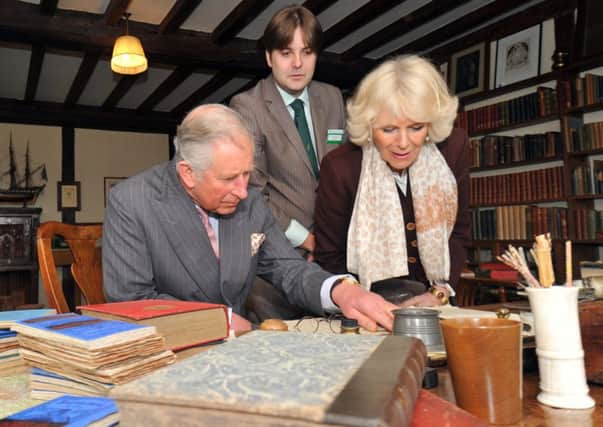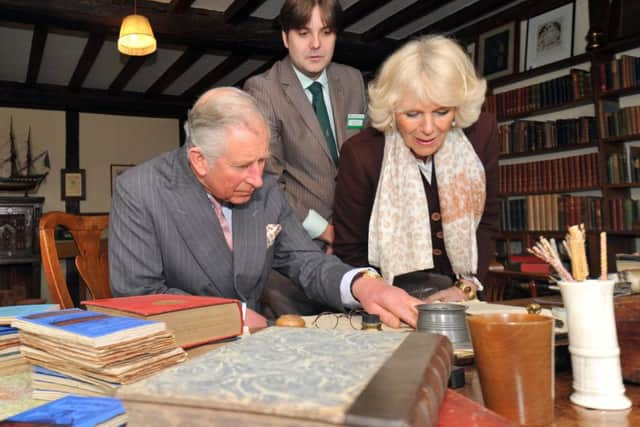Slideshow: Prince of Wales and Duchess of Cornwall visit Bateman’s in Burwash


The royal couple spent over an hour at the house, following their visit to Yalding in Kent where they met and talked to victims of the recent flooding.
The Prince of Wales and Duchess of Cornwall then toured the house and garden including Kipling’s study; the dining room where the couple entertained famous political figures of the age such as Stanley Baldwin and George Clemenceau (architect of the Parish peace conference at the close of World War I) they also spent time in the schoolroom where they viewed items from the Bateman’s archive including letters written by Jack, Kipling’s son who was killed during that War.
Advertisement
Hide AdAdvertisement
Hide AdRudyard Kipling was the author of ‘The Jungle Book,’ Puck of Pook’s Hill (about the hill visible from his window) and the poem ‘If’ (often voted the nation’s favourite.)


He was a world-famous poet and writer who moved from Rottingdean to settle at Bateman’s in the heart of the Weald.
Known as a very private man, he bought the house and land for his family and to provide him with much-needed sanctuary.
Surrounded by the wooded landscape of the Sussex Weald, the house was built in 1684 as the home of a Wealden ironmaster. The rooms, described by him as ‘untouched and unfaked’, remain much as he left them, with oriental rugs and artefacts reflecting his strong association with the East.
Advertisement
Hide AdAdvertisement
Hide AdSix brick columns form a massive central chimneystack above the gabled facades.
Bateman’s is very much a family home, but is impressive none the less.
Today the rooms are left as they were when the Kipling family lived there. Kipling and his wife created interiors that complemented the 17th-century house.
The heart of the house is the book-lined study, at the top of the stairs, where Kipling worked.
Advertisement
Hide AdAdvertisement
Hide AdHe sat at a 17th-century walnut refectory table under the window and his writing tools, paperweight and pipe are still there.
Bateman’s also reflects Kipling’s strong links with the Indian sub continent.
There are oriental rugs in many rooms and the parlour displays Kipling’s collection of Indian works of art and artefacts. His bookplate shows a small figure reading on top of an elephant.
Exhibition rooms contain manuscripts, letters, and mementoes of Kipling’s life and work. When Kipling first went to Bateman’s on a house-hunting expedition in 1900 he fell in love with it at first sight. He purchased it in 1902, and made it his home, even paying for a new road to be built to the nearest main road.
Advertisement
Hide AdAdvertisement
Hide AdKipling’s poem The Land is inspired by the Bateman’s estate.
Bateman’s was also used in the coloured 1966 edition of Tintin, The Black Island as the basis for the residence of Müller, the ex-Nazi antagonist.
In the fictionalised adventure, the house is razed to the ground when a burning log from the hearth is used as a weapon during a scuffle.
Exterior scenes for the TV film My Boy Jack about the death of Kipling’s young son Jack in the First World War and his family’s grief were shot at Bateman’s.
Advertisement
Hide AdAdvertisement
Hide AdThere is a working watermill on the property using the waters of the River Dudwell supported by volunteers.
The mill race drives the waterwheel outside, and this in turn drives the wooden cogwheels on the ground floor inside.
These transfer power upstairs to the millstones.
One pair of millstones is encased in wood and has a bell to warn the miller when the corn in the hopper runs out.
In the grinding process the corn keeps the millstones apart, preventing sparks and a fire risk.
Advertisement
Hide AdAdvertisement
Hide AdThe bell has a strap which is held down by a full hopper of corn. When the hopper is nearly empty, the strap is released, thus ringing the bell.
After Kipling’s death in 1936 Bateman’s passed to his wife Carrie.
Following her death in 1939 the house and 330 acres of land were given to the National Trust as a memorial to her husband.